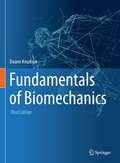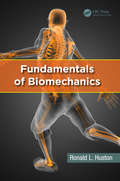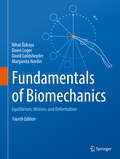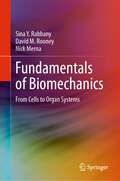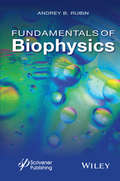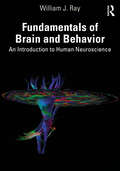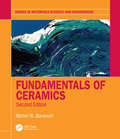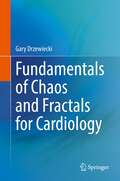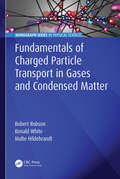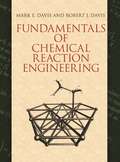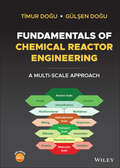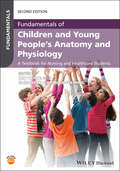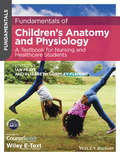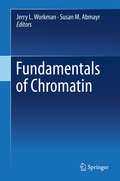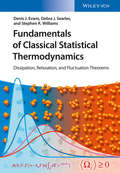- Table View
- List View
Fundamentals of Biomechanics
by Duane KnudsonBlending up-to-date biomechanical knowledge with professional application knowledge, this second edition presents a clear, conceptual approach to understanding biomechanics within the context of the qualitative analysis of human movement. It develops nine principles of biomechanics, which provide an applied structure for biomechanical concepts, and the application of each principle is fully explored in several chapters. The book also offers real-world examples of the application of biomechanics, which emphasize how biomechanics is integrated with the other subdisciplines of kinesiology to contribute to qualitative analysis of human movement.
Fundamentals of Biomechanics
by Ronald L. HustonIn the last three or four decades, studies of biomechanics have expanded from simple topical applications of elementary mechanics to entire areas of study. Studies and research in biomechanics now exceed those in basic mechanics itself, underlining the continuing and increasing importance of this area of study. With an emphasis on biodynamic modeli
Fundamentals of Biomechanics: Equilibrium, Motion, And Deformation
by Margareta Nordin David Goldsheyder Dawn Leger Nihat ÖzkayaThis textbook integrates the classic fields of mechanics--statics, dynamics, and strength of materials--using examples from biology and medicine. The book is excellent for teaching either undergraduates in biomedical engineering programs or health care professionals studying biomechanics at the graduate level. Extensively revised from a successful third edition, Fundamentals of Biomechanics features a wealth of clear illustrations, numerous worked examples, and many problem sets. The book provides the quantitative perspective missing from more descriptive texts, without requiring an advanced background in mathematics. It will be welcomed for use in courses such as biomechanics and orthopedics, rehabilitation and industrial engineering, and occupational or sports medicine. This book: Introduces the fundamental concepts, principles, and methods that must be understood to begin the study of biomechanics Reinforces basic principles of biomechanics with repetitive exercises in class and homework assignments given throughout the textbook Includes over 100 new problem sets with solutions and illustrations
Fundamentals of Biomechanics: From Cells to Organ Systems
by Sina Y. Rabbany David M. Rooney Nick MernaFundamentals of Biomechanics: From Cells to Organ Systems combines biology with engineering to provide a comprehensive overview of biomechanics. It covers cell, tissue, and fluid mechanics in a way that is easy to understand, requiring only a basic background in biology and mechanics. The book includes a wide range of topics, from single-cell mechanics to forces in the musculoskeletal system. Each chapter provides an introduction to biological systems, along with examples and practice problems throughout the text. The book also offers step-by-step derivation of equations from principles. This textbook has been classroom-tested and is designed for advanced undergraduate engineering courses in bioengineering, biomechanics, and physiology. It is also a valuable reference for graduate students, practicing engineers, and medical professionals. Integrates biology with engineering; Includes examples and practice problems throughout the text; Requires a limited background in biology and mechanics.
Fundamentals of Biophysics
by Andrey B. RubinBiophysics is a science that comprises theoretical plotting and models based on contemporary physicochemical conceptions. They mirror physical specificity of the molecular organization and elementary processes in living organisms, which in their turn form the molecular basis of biological phenomena. Presentation of a complete course in biophysics requires vast biological material as well as additional involvement of state-of-the-art concepts in physics, chemistry and mathematics. This is essential for the students to "perceive" the specific nature and peculiarity of molecular biological processes and see how this specificity is displayed in biological systems. This is the essence of the up-to-date biophysical approach to the analysis of biological processes. Fundamentals of Biophysics offers a complete, thorough coverage of the material in a straightforward and no-nonsense format, offering a new and unique approach to the material that presents the appropriate topics without extraneous and unneeded filler material.
Fundamentals of Brain and Behavior: An Introduction to Human Neuroscience
by William J. RayFundamentals of Brain and Behavior provides an accessible introduction to the study of human neuroscience. The book has been carefully designed to accompany a typical entry-level course, covering core topics including the function and structure of the nervous system, basic human motivations, stress and health, and cognitive functioning. In addition to traditional topics, the book also includes dedicated chapters on the social brain, neurocognitive disorders, and brain imaging techniques, ensuring students gain a thorough understanding of the field in its broadest sense. An evolutionary approach is also taken throughout, providing a truly unique perspective on our understanding of brain and behavior. The text is supported by colorful and informative diagrams, alongside a plethora of student-friendly features such as learning objectives, case studies, and concept checks. The book is also supported by online resources including basics of neuroscience videos. Helping students understand the basics of human neuroscience across evolutionary time, Fundamentals of Brain and Behavior is an essential text for all students of Behavioral Neuroscience, especially those approaching the subject for the first time.
Fundamentals of Ceramics (Series in Materials Science and Engineering)
by Michel BarsoumFundamentals of Ceramics presents readers with an exceptionally clear and comprehensive introduction to ceramic science. This Second Edition updates problems and adds more worked examples, as well as adding new chapter sections on Computational Materials Science and Case Studies. The Computational Materials Science sections describe how today density functional theory and molecular dynamics calculations can shed valuable light on properties, especially ones that are not easy to measure or visualize otherwise such as surface energies, elastic constants, point defect energies, phonon modes, etc. The Case Studies sections focus more on applications, such as solid oxide fuel cells, optical fibers, alumina forming materials, ultra-strong and thin glasses, glass-ceramics, strong and tough ceramics, fiber-reinforced ceramic matrix composites, thermal barrier coatings, the space shuttle tiles, electrochemical impedance spectroscopy, two-dimensional solids, field-assisted and microwave sintering, colossal magnetoresistance, among others.
Fundamentals of Chaos and Fractals for Cardiology
by Gary DrzewieckiThis textbook serves as an introduction to nonlinear dynamics and fractals for physiological modeling. Examples and demonstrations from current research in cardiopulmonary engineering and neuro-systems engineering are provided, as well as lab and computer exercises that encourage readers to apply the course material. This is an ideal textbook for graduate students in biomedical engineering departments, researchers who analyze physiological data, and researchers interested in physiological modeling.
Fundamentals of Charged Particle Transport in Gases and Condensed Matter (Monograph Series in Physical Sciences)
by Ronald White Robert Robson Malte HildebrandtThis book offers a comprehensive and cohesive overview of transport processes associated with all kinds of charged particles, including electrons, ions, positrons, and muons, in both gases and condensed matter. The emphasis is on fundamental physics, linking experiment, theory and applications. In particular, the authors discuss: The kinetic theory of gases, from the traditional Boltzmann equation to modern generalizations A complementary approach: Maxwell’s equations of change and fluid modeling Calculation of ion-atom scattering cross sections Extension to soft condensed matter, amorphous materials Applications: drift tube experiments, including the Franck-Hertz experiment, modeling plasma processing devices, muon catalysed fusion, positron emission tomography, gaseous radiation detectors Straightforward, physically-based arguments are used wherever possible to complement mathematical rigor. Robert Robson has held professorial positions in Japan, the USA and Australia, and was an Alexander von Humboldt Fellow at several universities in Germany. He is a Fellow of the American Physical Society. Ronald White is Professor of Physics and Head of Physical Sciences at James Cook University, Australia. Malte Hildebrandt is Head of the Detector Group in the Laboratory of Particle Physics at the Paul Scherrer Institut, Switzerland.
Fundamentals of Chemical Reaction Engineering (Dover Civil and Mechanical Engineering)
by Robert J. Davis Mark E. DavisAppropriate for a one-semester undergraduate or first-year graduate course, this text introduces the quantitative treatment of chemical reaction engineering. It covers both homogeneous and heterogeneous reacting systems and examines chemical reaction engineering as well as chemical reactor engineering. Each chapter contains numerous worked-out problems and real-world vignettes involving commercial applications, a feature widely praised by reviewers and teachers. 2003 edition.
Fundamentals of Chemical Reactor Engineering: A Multi-Scale Approach
by Timur Dogu Gulsen DoguFUNDAMENTALS OF CHEMICAL REACTOR ENGINEERING A comprehensive introduction to chemical reactor engineering from an industrial perspective In Fundamentals of Chemical Reactor Engineering: A Multi-Scale Approach, a distinguished team of academics delivers a thorough introduction to foundational concepts in chemical reactor engineering. It offers readers the tools they need to develop a firm grasp of the kinetics and thermodynamics of reactions, hydrodynamics, transport processes, and heat and mass transfer resistances in a chemical reactor. This textbook describes the interaction of reacting molecules on the molecular scale and uses real-world examples to illustrate the principles of chemical reactor analysis and heterogeneous catalysis at every scale. It includes a strong focus on new approaches to process intensification, the modeling of multifunctional reactors, structured reactor types, and the importance of hydrodynamics and transport processes in a chemical reactor. With end-of-chapter problem sets and multiple open-ended case studies to promote critical thinking, this book also offers supplementary online materials and an included instructor’s manual. Readers will also find: A thorough introduction to the rate concept and species conservation equations in reactors, including chemical and flow reactors and the stoichiometric relations between reacting species A comprehensive exploration of reversible reactions and chemical equilibrium, including the thermodynamics of chemical reactions and different forms of the equilibrium constant Practical discussions of chemical kinetics and analysis of batch reactors, including batch reactor data analysis In-depth examinations of ideal flow reactors, CSTR, and plug flow reactor models Ideal for undergraduate and graduate chemical engineering students studying chemical reactor engineering, chemical engineering kinetics, heterogeneous catalysis, and reactor design, Fundamentals of Chemical Reactor Engineering is also an indispensable resource for professionals and students in food, environmental, and materials engineering.
Fundamentals of Children and Young People's Anatomy and Physiology: A Textbook for Nursing and Healthcare Students (Fundamentals)
by Ian Peate Elizabeth Gormley‐FLEMINGFundamentals of Children and Young People’s Anatomy and Physiology contains the critical knowledge required to provide safe and effective care to young people. Emphasising the application of evidence-based theory to practice, this comprehensive yet accessible textbook helps nursing and healthcare students understand how children’s anatomical and physiological systems influence disease processes and treatment options differently than in adults. Highly visual, succinct yet comprehensive, this textbook presents an overview of the structure and function of each body system, supported by clinical applications demonstrating how the concepts relate to nursing in practice. Fully revised to reflect the Future Nurse Curriculum Standards, this second edition contains a new chapter on physical growth and development, discussion of social, political, and environmental impacts to children’s health and wellbeing, updated problems and activities, and more. Each chapter includes a range of effective pedagogical tools, such as learning objectives, clinical considerations, body maps, and self-assessment questions. Designed to prepare students for their careers in delivering high-quality care for children in a range of settings, this leading textbook: Provides information on the anatomical and physiological changes that leads to an altered state of health Emphasises clinical application throughout, applying the anatomy and physiology to common health conditions in children Offers a structured and comprehensive approach to child-related anatomy and physiology theory to prepare students for practice Fundamentals of Children and Young People’s Anatomy and Physiology is essential reading for nursing and healthcare students, and a useful reference for nurses, nursing associates, healthcare assistants, assistant practitioners, and other professionals working in the field. All content is reviewed by students for students. If you would like to be one of our student reviewers, go to www.reviewnursingbooks.com to find out more.
Fundamentals of Children's Anatomy and Physiology
by Ian Peate Elizabeth Gormley-FlemingWhen caring for the well or ill child, recognising andresponding to their anatomical and physiological differences isessential. Fundamentals of Children's Anatomy andPhysiology provides child nursing students and registerednurses with a succinct but complete overview of the structure andfunction of the child's body, plus clinical applicationsthroughout to demonstrate how the concepts relate to real-lifenursing. Each chapter lists learning outcomes andincludes clinical considerations, body maps, a range ofhigh-quality illustrations and test-your-knowledge questions. The book is also accompanied by a companion website with furtherself-assessment and quizzes.
Fundamentals of Chromatin
by Jerry L. Workman Susan M. AbmayrWhile there has been an increasing number of books on various aspects of epigenetics, there has been a gap over the years in books that provide a comprehensive understanding of the fundamentals of chromatin. Chromatin is the combination of DNA and proteins that make up the genetic material of chromosomes. Its primary function is to package DNA to fit into the cell, to strengthen the DNA to prevent damage, to allow mitosis and meiosis, and to control the expression of genes and DNA replication. The audience for this book is mainly newly established scientists and graduate students. Rather than going into the more specific areas of recent research on chromatin the chapters in this book give a strong, updated groundwork about the topic. Some the fundamentals that this book will cover include the structure of chromatin and biochemistry and the enzyme complexes that manage it.
Fundamentals of Classical Statistical Thermodynamics: Dissipation, Relaxation, and Fluctuation Theorems
by Denis James Evans Stephen Rodney Williams Debra Joy SearlesBoth a comprehensive overview and a treatment at the appropriate level of detail, this textbook explains thermodynamics and generalizes the subject so it can be applied to small nano- or biosystems, arbitrarily far from or close to equilibrium. In addition, nonequilibrium free energy theorems are covered with a rigorous exposition of each one. Throughout, the authors stress the physical concepts along with the mathematical derivations. For researchers and students in physics, chemistry, materials science and molecular biology, this is a useful text for postgraduate courses in statistical mechanics, thermodynamics and molecular simulations, while equally serving as a reference for university teachers and researchers in these fields.
Fundamentals of Cognitive Neuroscience: A Beginner's Guide
by Bernard Baars Nicole M. GageFundamentals of Cognitive Neuroscience, winner of a 2013 Most Promising New Textbook Award from the Text and Academic Authors Association, offers a comprehensive and easy-to-follow guide to cognitive neuroscience. Chapters in this introductory text cover all aspects of the field-the neural framework, sight, sound, consciousness, learning/memory, problem solving, speech, executive control, emotions, socialization and development-in a student-friendly format with extensive pedagogy and ancillaries to aid both the student and professor. Throughout the text, case studies and everyday examples are used to help students understand the more challenging aspects of the material. Written by two leading experts in the field, the text takes a unique thematic approach, guiding students along a clear path to understand the latest findings whether or not they have a background in neuroscience.
Fundamentals of Combustion Engineering
by Achintya Mukhopadhyay Swarnendu SenThis book is an introductory text on fundamental aspects of combustion including thermodynamics, heat and mass transfer and chemical kinetics which are used to systematically derive the basic concepts of combustion. Apart from the fundamental aspects, many of the emerging topics in the field like microscale combustion, combustion dynamics, oxy-fuel combustion and combustion diagnostics are also covered in the book. This would help the beginners in the subject to get initiated to the state of the art topics. Key Features: Coverage of the essential aspects of combustion engineering suitable for both beginners and practicing professionals Topics like entropy generation, microscale combustion, combustion diagnostics, second law-based analysis exclusive to the title Balanced treatment of thermodynamics, transport phenomena and chemical kinetics Discussion on state of the art techniques in combustion diagnostics Illustrates combustion of gaseous, liquid and solid fuels along with emission of pollutants and greenhouse gases
Fundamentals of Combustion Processes
by Jyh-Yuan Chen A. Carlos Fernandez-Pello Sara McallisterFundamentals of Combustion Processes is designed as a textbook for an upper-division undergraduate and graduate level combustion course in mechanical engineering. The authors focus on the fundamental theory of combustion and provide a simplified discussion of basic combustion parameters and processes such as thermodynamics, chemical kinetics, ignition, diffusion and pre-mixed flames. The text includes exploration of applications, example exercises, suggested homework problems and videos of laboratory demonstrations
Fundamentals of Computational Fluid Dynamics: The Finite Volume Method (Fluid Mechanics and Its Applications #135)
by Clovis R. MaliskaThis book presents the developments of the finite volume method applied to fluid flows, starting from the foundations of the method and reaching the latest approaches using unstructured grids. It helps students learn progressively, creating a strong background on CFD. The text is divided into two parts. The first one is about the basic concepts of the finite volume method, while the second one presents the formulation of the finite volume method for any kind of domain discretization. In the first part of the text, for the sake of simplicity, the developments are done using the Cartesian coordinate system, without prejudice to the complete understanding. The second part extends this knowledge to curvilinear and unstructured grids. As such, the book contains material for introductory courses on CFD for under and graduate students, as well as for more advanced students and researchers.
Fundamentals of Condensed Matter Physics
by Marvin L. Cohen Steven G. LouieBased on an established course and covering the fundamentals, central areas, and contemporary topics of this diverse field, Fundamentals of Condensed Matter Physics is a much-needed textbook for graduate students. The book begins with an introduction to the modern conceptual models of a solid from the points of view of interacting atoms and elementary excitations. It then provides students with a thorough grounding in electronic structure and many-body interactions as a starting point to understand many properties of condensed matter systems - electronic, structural, vibrational, thermal, optical, transport, magnetic and superconducting - and methods to calculate them. Taking readers through the concepts and techniques, the text gives both theoretically and experimentally inclined students the knowledge needed for research and teaching careers in this field. It features 246 illustrations, 9 tables and 100 homework problems, as well as numerous worked examples, for students to test their understanding. Solutions to the problems for instructors are available at www. cambridge. org/cohenlouie.
Fundamentals of Condensed Matter and Crystalline Physics
by David L. SidebottomThis undergraduate textbook merges traditional solid state physics with contemporary condensed matter physics, providing an up-to-date introduction to the major concepts that form the foundations of condensed materials. The main foundational principles are emphasized, providing students with the knowledge beginners in the field should understand. The book is structured in four parts and allows students to appreciate how the concepts in this broad area build upon each other to produce a cohesive whole as they work through the chapters. Illustrations work closely with the text to convey concepts and ideas visually, enhancing student understanding of difficult material, and end-of-chapter exercises varying in difficulty allow students to put into practice the theory they have covered in each chapter and reinforce new concepts.
Fundamentals of Conjugated Polymer Blends, Copolymers and Composites
by Parveen SainiSince their discovery in 1977, the evolution of conducting polymers has revolutionized modern science and technology. These polymers enjoy a special status in the area of materials science yet they are not as popular among young readers or common people when compared to other materials like metals, paper, plastics, rubber, textiles, ceramics and composites like concrete. Most importantly, much of the available literature in the form of papers, specific review articles and books is targeted either at advanced readers (scientists/technologists/engineers/senior academicians) or for those who are already familiar with the topic (doctoral/postdoctoral scholars). For a beginner or even school/college students, such compilations are bit difficult to access/digest. In fact, they need proper introduction to the topic of conducting polymers including their discovery, preparation, properties, applications and societal impact, using suitable examples and already known principles/knowledge/phenomenon. Further, active participation of readers in terms of "question & answers", "fill-in-the-blanks", "numerical" along with suitable answer key is necessary to maintain the interest and to initiate the "thought process". The readers also need to know about the drawbacks and any hazards of such materials. Therefore, I believe that a comprehensive source on the science/technology of conducting polymers which maintains a link between grass root fundamentals and state-of-the-art R&D is still missing from the open literature.
Fundamentals of Continuum Mechanics
by John W. RudnickiA concise introductory course text on continuum mechanicsFundamentals of Continuum Mechanics focuses on the fundamentals of the subject and provides the background for formulation of numerical methods for large deformations and a wide range of material behaviours. It aims to provide the foundations for further study, not just of these subjects, but also the formulations for much more complex material behaviour and their implementation computationally. This book is divided into 5 parts, covering mathematical preliminaries, stress, motion and deformation, balance of mass, momentum and energy, and ideal constitutive relations and is a suitable textbook for introductory graduate courses for students in mechanical and civil engineering, as well as those studying material science, geology and geophysics and biomechanics. A concise introductory course text on continuum mechanicsCovers the fundamentals of continuum mechanicsUses modern tensor notationContains problems and accompanied by a companion website hosting solutionsSuitable as a textbook for introductory graduate courses for students in mechanical and civil engineering
Fundamentals of Convective Heat Transfer
by Gautam Biswas Amaresh Dalal Vijay DhirThermal convection is often encountered by scientists and engineers while designing or analyzing flows involving exchange of energy. Fundamentals of Convective Heat Transfer is a unified text that captures the physical insight into convective heat transfer and thorough, analytical, and numerical treatments. It also focuses on the latest developments in the theory of convective energy and mass transport. Aimed at graduates, senior undergraduates, and engineers involved in research and development activities, the book provides new material on boiling, including nuances of physical processes. In all the derivations, step-by-step and systematic approaches have been followed.
Fundamentals of Corrosion: Mechanisms, Causes, and Preventative Methods (Corrosion Technology)
by P.E., Philip SchweitzerWritten by an authority in corrosion science, this reference offers a comprehensive description of the causes of corrosion as well as the means to limit or prevent it. It explains the mechanisms and forms of corrosion, the methods of attack on plastic materials, and the causes of failure in protective coatings, linings, and paints. Emphasizing atmospheric exposure, the text presents vital information regarding the design of structures, automobiles, household plumbing, manufacturing equipment, and other entities, as well as the effects of de-icing chemicals on highways and bridges.
